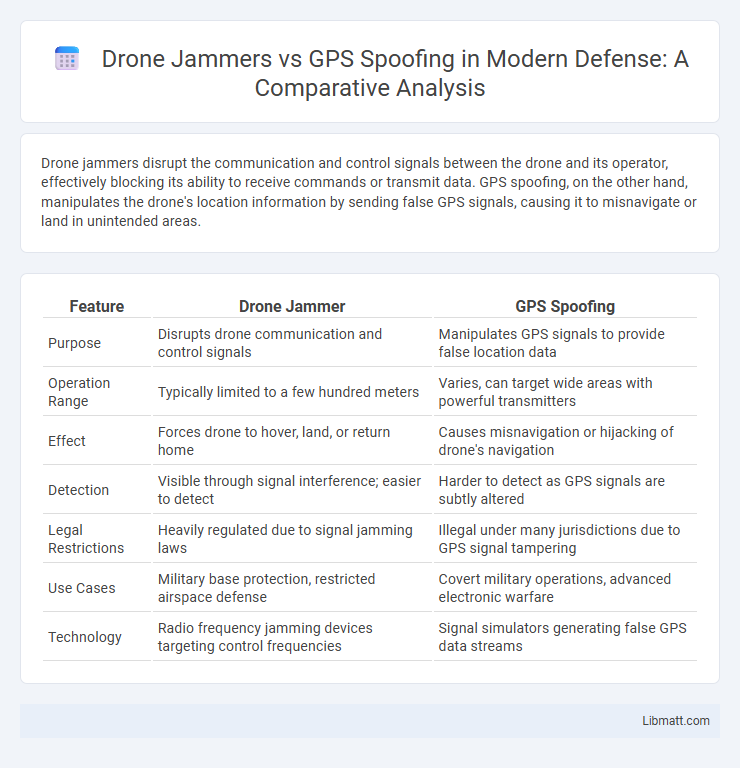Drone jammers disrupt the communication and control signals between the drone and its operator, effectively blocking its ability to receive commands or transmit data. GPS spoofing, on the other hand, manipulates the drone's location information by sending false GPS signals, causing it to misnavigate or land in unintended areas.
Table of Comparison
| Feature | Drone Jammer | GPS Spoofing |
|---|---|---|
| Purpose | Disrupts drone communication and control signals | Manipulates GPS signals to provide false location data |
| Operation Range | Typically limited to a few hundred meters | Varies, can target wide areas with powerful transmitters |
| Effect | Forces drone to hover, land, or return home | Causes misnavigation or hijacking of drone's navigation |
| Detection | Visible through signal interference; easier to detect | Harder to detect as GPS signals are subtly altered |
| Legal Restrictions | Heavily regulated due to signal jamming laws | Illegal under many jurisdictions due to GPS signal tampering |
| Use Cases | Military base protection, restricted airspace defense | Covert military operations, advanced electronic warfare |
| Technology | Radio frequency jamming devices targeting control frequencies | Signal simulators generating false GPS data streams |
Introduction: Understanding Drone Threats
Drone jammers disrupt unauthorized drones by emitting signals that interfere with their communication systems, effectively preventing them from operating in restricted areas. GPS spoofing deceives a drone's navigation system by sending fake GPS signals, causing the drone to misinterpret its location and potentially divert it from its intended path. Understanding these technologies helps you protect sensitive airspace from drones posing security, privacy, or safety threats.
What is a Drone Jammer?
A drone jammer is a device designed to disrupt the communication between a drone and its remote controller by emitting radio frequency signals that interfere with the drone's control and GPS signals. Unlike GPS spoofing, which tricks a drone into misinterpreting its location, a drone jammer blocks the drone's ability to receive commands, effectively forcing it to hover, land, or return to its point of origin. Your security measures can benefit from a drone jammer in situations where preventing unauthorized drone access is critical.
How Drone Jammers Work
Drone jammers disrupt communication signals by emitting radio frequency interference, effectively blocking the drone's control link and GPS signals, causing it to lose navigation or return to its origin. These devices target specific frequency bands used by drones, such as 2.4 GHz and 5.8 GHz, to sever the connection between the drone and its remote controller. Your security strategy can benefit from drone jammers by preventing unauthorized drone activity through controlled signal denial without relying on GPS spoofing techniques.
Defining GPS Spoofing
GPS spoofing involves the transmission of counterfeit GPS signals to deceive a drone's navigation system, causing it to misinterpret its actual location. Unlike drone jammers that block or interfere with drone signals to disrupt communication, GPS spoofing manipulates positional data, potentially redirecting the drone or causing it to malfunction. This technique exploits vulnerabilities in GPS receivers, enabling attackers to take control without alerting standard anti-drone defenses.
How GPS Spoofing Operates Against Drones
GPS spoofing operates against drones by transmitting counterfeit GPS signals that mimic legitimate satellite data, causing the drone's navigation system to misinterpret its true location. This deception manipulates the drone to deviate from its intended flight path or land in a controlled area, bypassing traditional signal jammers. Your drone's reliance on authentic GPS coordinates makes it vulnerable to such sophisticated electronic attacks.
Key Differences Between Drone Jammers and GPS Spoofing
Drone jammers emit radio frequency signals to disrupt communication between a drone and its controller, effectively preventing the drone from receiving control commands or transmitting data. GPS spoofing manipulates the drone's GPS signals by sending false location information, causing the drone to misinterpret its position and navigate incorrectly. Understanding these key differences helps you choose the appropriate countermeasure depending on whether you want to block control signals or deceive the drone's navigation system.
Effectiveness in Counter-Drone Operations
Drone jammers disrupt communication links between drones and their operators by emitting radio frequency signals, effectively neutralizing unwanted drones within a specific radius. GPS spoofing manipulates a drone's navigation system by sending false GPS signals, causing the drone to misinterpret its location and lose control or return to a designated point. You should consider drone jammers for immediate and area-wide interruption, whereas GPS spoofing offers precision in redirecting or capturing drones without physical interference.
Legal and Ethical Considerations
Drone jammer use is regulated under laws that prohibit unauthorized signal interference, making their deployment legally risky without proper authorization. GPS spoofing involves deceitful signal manipulation, raising significant ethical concerns about privacy invasion and potential safety hazards in aviation. Both technologies require strict adherence to legal frameworks and ethical guidelines to prevent misuse and ensure responsible operation in drone management.
Practical Applications and Use Cases
Drone jammers are primarily used for real-time disruption of unauthorized drone flights in restricted areas such as airports, military bases, and large public events, ensuring immediate neutralization of potential threats. GPS spoofing manipulates drone navigation by feeding false location data, often employed in controlled testing environments or cyber defense training to simulate hijacking scenarios without physical interference. Your choice between the two depends on whether you need instant drone disablement or a covert method to mislead drone operators.
Choosing the Right Counter-Drone Solution
Selecting the right counter-drone solution depends on your specific security needs and environment. Drone jammers effectively disrupt unauthorized drone signals by emitting interference, making them ideal for immediate area protection. GPS spoofing targets the drone's navigation system, misleading its GPS receiver, which works better for controlling or redirecting drones without physical interception.
drone jammer vs GPS spoofing Infographic

 libmatt.com
libmatt.com